 W
WGuy Anderson was an American artist known primarily for his oil painting who lived most of his life in the Puget Sound region of the United States. His work is in the collections of numerous museums including the Seattle Art Museum, the Tacoma Art Museum, and the Metropolitan Museum of Art. He has been called "Perhaps the most powerful artist to emerge from the Northwest School".
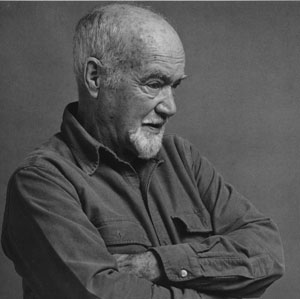 W
WKenneth Callahan (1905–1986) was an American painter and muralist who served as a catalyst for Northwest artists in the mid-20th century through his own painting, his work as assistant director and curator at the Seattle Art Museum, and his writings about contemporary art. Born in Eastern Washington and largely self-taught as an artist, Callahan was committed to an art that went beyond the merely illustrative. He enrolled at the University of Washington in 1924 but did not stay long. He traveled widely, absorbing influences from the different countries and cultures he experienced. His talent was recognized early; his work was included in the first Whitney Biennial exhibition in 1933 and he went on to a distinguished painting career. Callahan is identified as one of the Northwest Mystics – along with Guy Anderson, Morris Graves, and Mark Tobey, who shared a muted palette and strong interest in Asian aesthetics.
 W
WAndrew Chinn (1915–1996) was a Chinese-American artist and art educator, active in the Pacific Northwest from the early 1930s through the 1990s. He is known for his distinctive style of watercolor painting and printmaking, and is associated with the Northwest's Asian-American arts community, the WPA artists of the Great Depression/World War II era, and, peripherally, the Northwest School of painters.
 W
WFay Chong (1912–1973) was a Chinese-American artist and educator, well known for his printmaking and watercolor painting. He was also known for his activities as an arts organizer, arts educator and WPA-era artist. Chong was active in the Pacific Northwest.
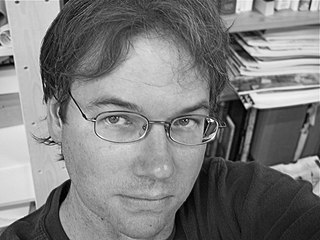 W
WGreg Colson is an American artist best known for works that straddle the line between painting and sculpture that address concepts of efficiency and order. Using scavenged materials, Colson allows the physicality of his makeshift constructions to intrude on the precise systems he paints or draws upon their surfaces - striking a balance between subject and context, image and support, order and chaos.
 W
WWilliam Lee "Bill" Cumming is a noted 20th-century American artist, often associated with the Northwest School. A controversial figure - he was a hardcore Stalinist for a long period, was married seven times, and was generally outspoken and opinionated - he eventually came to be respected as an important innovator and highly distinctive stylist in modern art, particularly in the Pacific Northwest.
 W
WBetsy Eby is an American artist and musician known for her abstract encaustic paintings. Eby lives and works in Columbus, Georgia and Wheaton Island, Maine.
 W
WJacob Alexander Elshin (1892-1976) was a Russian American artist. Born in 1892 in Saint Petersburg, Russia, he served as an officer in the Imperial Russian Army, and may have been a student at the St. Petersburg Academy. He arrived in Seattle in 1923 where he was described as a "straight pictorialist". His art was commissioned by the Works Progress Administration's Federal Art Project, where he worked with Mark Tobey, Helmi Juvonen, and others. He also provided services to the U.S. Treasury Department's Section of Painting and Sculpture. Elshin socialized with other artists at the Chinese Art Club. He died in Seattle in 1976.
 W
WDavid Fairrington is an American artist. Mostly associated with his realistic portraits, Fairrington paints a variety of subjects including landscapes, still life, and western art in a range of styles including abstract, conceptual, fantasy, figurative, impressionist, pop art and romantic. He attributes artist John Singer Sargent and famed illustrator Norman Rockwell as significant influences in his work.
 W
WAnn Gale is an American figurative painter based in Seattle, Washington. She is known for her portrait paintings, which consist of an accumulation of small color patches expressing the changing light and the shifting position of her models over time. Some of her main influences are Lucian Freud, Alberto Giacometti, and Antonio López García.
 W
WRichard Charles Gilkey was an American painter, often associated with the 'Northwest School' of artists. During his long career he became one of the most acclaimed painters in the Pacific Northwest, with an original and highly distinctive style. He was particularly well known for his landscapes depicting the Skagit Valley in western Washington.
 W
WMorris Graves was an American painter. He was one of the earliest Modern artists from the Pacific Northwest to achieve national and international acclaim. His style, referred to by some reviewers as Mysticism, used the muted tones of the Northwest environment, Asian aesthetics and philosophy, and a personal iconography of birds, flowers, chalices, and other images to explore the nature of consciousness.
 W
WPaul Havas was an American painter. Havas is known for his landscape paintings.
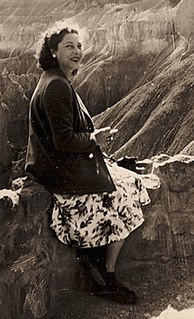 W
WZ. Vanessa Helder was an American watercolor painter who gained national attention in the 1930s and 40s, mainly for her paintings of scenes in Eastern Washington. She painted with a bold, Precisionist style not commonly associated with watercolor, rendering landscapes, industrial scenes, and houses with a Magic Realist touch that gave them a forlorn, isolated quality, somewhat in the manner of Charles Sheeler and Edward Hopper. She spent most of her career in the Pacific Northwest, but was popular in New York art galleries, was a member of the National Association of Women Painters and Sculptors, and, in 1943, was included in a major exhibit at the Museum of Modern Art.
 W
WMary Henry, born Mary M. Dill, was an American artist whose work, most notably large oil paintings and acrylics but also prints, was characteristized by geometric abstraction. Many of her pieces are diptychs and some are triptychs. Some of her work resembles, variously, op art, constructivism, or even psychedelic art.
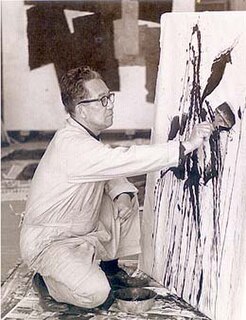 W
WPaul Horiuchi (1906–1999) was an American painter and collagist. He was born in Oishi, Japan, and studied art from an early age. After immigrating to the United States in his early teens, he spent many years as a railroad worker in the Western U.S. In 1946, he moved to Seattle, Washington, where he eventually switched his focus from painting to collage and came to be associated with the "Northwest School" of artists. In his mid-forties, he was finally able to devote himself to art full-time, his unusual collage style becoming very popular in the 1950s and 60s. He continued creating art at his studio in Seattle until succumbing to Alzheimer's-related health problems in 1999.
 W
WWilliam Ivey was an American abstract expressionist painter, sometimes associated with the Northwest School of artists. After stints in the US Army and studying art in California, he spent most of his career in Seattle, Washington. Seattle Times critic Deloris Tarzan Ament described him as "the Dean of Northwest Painters".
 W
WFay Jones is an American artist, based in Seattle, Washington. A large number of her works are exhibited in public places in the Pacific Northwest, including a mural in the Westlake Station of the Downtown Seattle Transit Tunnel and a painting in Seattle's opera house, McCaw Hall. A 1986 retrospective organized by the Boise Art Museum also showed at the Seattle Art Museum.
 W
WJulia Cornelia Slaughter was an American artist and community leader. She started her career as a painter in England, creating portraits and landscapes in oil, watercolor, and pastel. Later, she focused on still-lifes and landscapes. In about 1876, she moved to New York and exhibited in major city exhibitions, including the National Academy of Design, American Art Association, and Society of American Artists. Slaughter spent some time in San Francisco and arrived to Tacoma in 1891, where in later years she was highly esteemed in social and art circles.
 W
WLeo Kenney (1925–2001) was an American abstract painter, described by critics as a leading figure in the second generation of the 'Northwest School' of artists.
 W
WJohn-Franklin Koenig was an American artist who, though born and raised in Seattle, Washington, and sometimes associated with the 'Northwest School' of artists, spent most of his career in France. He was primarily a painter and collagist, working in a modern, non-representational style. His work appeared in hundreds of exhibitions around the world. He died in Seattle in 2008.
 W
WJohn Takehisa Matsudaira was an American painter active mainly in Seattle, Washington from the 1940s through the 1970s. He was involved in the Pacific Northwest's vibrant Asian-American art community, and is sometimes associated with the 'Northwest School' of artists.
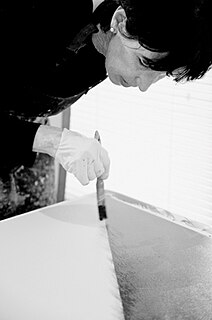 W
WBetty Merken is an American painter and printmaker who lives and works in Seattle, Washington.
 W
WE. W. Moore was an American painter, photographer, and gallery owner.
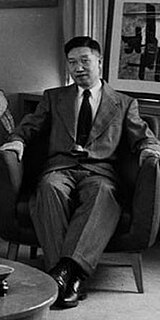 W
WKenjiro Nomura (1896–1956) was a Japanese American painter. Immigrating to the United States from Japan as a boy, he became a well-known artist in the Pacific Northwest in the 1920s and 30s.
 W
WFrank Okada was an American Abstract Expressionist painter, mainly active in the Pacific Northwest. His mature style often featured brightly colored, off-kilter geometric shapes done in large format, including round canvasses; subtly elaborate brushwork suggested the influence of both traditional Asian art and the "mystics" of the Northwest School. His later work at times used symbolic shapes which more directly evoked his Nisei heritage and the years he spent in detention camps with his family during World War II.
 W
WLeno Prestini (1906–1963) was an American painter and sculptor who was active from the 1920s through the early 1960s, mainly in the small town of Clayton, Washington. He worked as a professional terra cotta sculptor, creating architectural ornaments, and had many other interests as well. His skillfully rendered paintings, though reflecting contemporary trends such as Surrealism and Social Realism, were at times unique to the point of eccentricity. His work received limited acclaim in his lifetime, but has been the subject of several exhibitions, and has continued to attract attention since his death in 1963.
 W
WJay Steensma (1941–1994), also known as J. Steensma, was an American artist, primarily a painter, sometimes described by reviewers as a later-day exponent of the Northwest School of artists. He was known for his extremely prolific output, and, at times, unusual media. Chalices, snakes, houses, clouds, birds, and fish were frequent subjects in his work. He was one of the more successful artists in the Pacific Northwest in the 1980s and 90s, but had longstanding health problems, and died in Seattle at age 52.
 W
WClyfford Still was an American painter, and one of the leading figures in the first generation of Abstract Expressionists, who developed a new, powerful approach to painting in the years immediately following World War II. Still has been credited with laying the groundwork for the movement, as his shift from representational to abstract painting occurred between 1938 and 1942, earlier than his colleagues like Jackson Pollock and Mark Rothko, who continued to paint in figurative-surrealist styles well into the 1940s.
 W
WThelma Beatrice Johnson Streat was an African-American artist, dancer, and educator. She gained prominence in the 1940s for her art, performance and work to foster intercultural understanding and appreciation.
 W
WMark George Tobey was an American painter. His densely structured compositions, inspired by Asian calligraphy, resemble Abstract expressionism, although the motives for his compositions differ philosophically from most Abstract Expressionist painters. His work was widely recognized throughout the United States and Europe. Along with Guy Anderson, Kenneth Callahan, Morris Graves, and William Cumming, Tobey was a founder of the Northwest School. Senior in age and experience, he had a strong influence on the others; friend and mentor, Tobey shared their interest in philosophy and Eastern religions. Similar to others of the Northwest School, Tobey was mostly self-taught after early studies at the Art Institute of Chicago. In 1921, Tobey founded the art department at The Cornish School in Seattle, Washington.
 W
WKamekichi Tokita (1897–1948) was a Japanese American painter and diarist. He immigrated to the United States from Japan in 1919, and lived in Seattle, Washington's Japantown/Nihonmachi district. He was a prominent figure in the Pacific Northwest art world of the 1930s, with paintings regularly included in major exhibitions.
 W
WMargaret Tomkins (1916–2002) was an American Surrealist / Abstract Expressionist painter. Though born, raised, and educated in Southern California, she spent most of her life in the Pacific Northwest, where she was well known both for her art and her energetic, outspoken art activism. Her Surrealist works of the 1940s earned considerable national attention, and as her work evolved in the 1950s and 1960s, she came to be known as a pioneer in Abstract Expressionism. Tomkins was the driving force behind the first artist-owned gallery in Seattle, Washington. Though friends with many of the artists of the Northwest School, she denied any artistic connection to these "mystic" painters, at times deriding their claims of quasi-magical inspiration from nature as "silly". She was similarly dismissive of any categorization based on her gender.
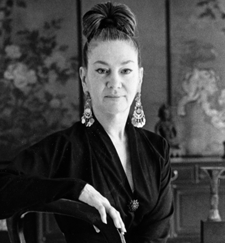 W
WLeona Wood was a 20th-century American painter, dancer, writer and co-founder of the Aman International Folk Ensemble. Her early paintings were considered a part of the Surrealism school.